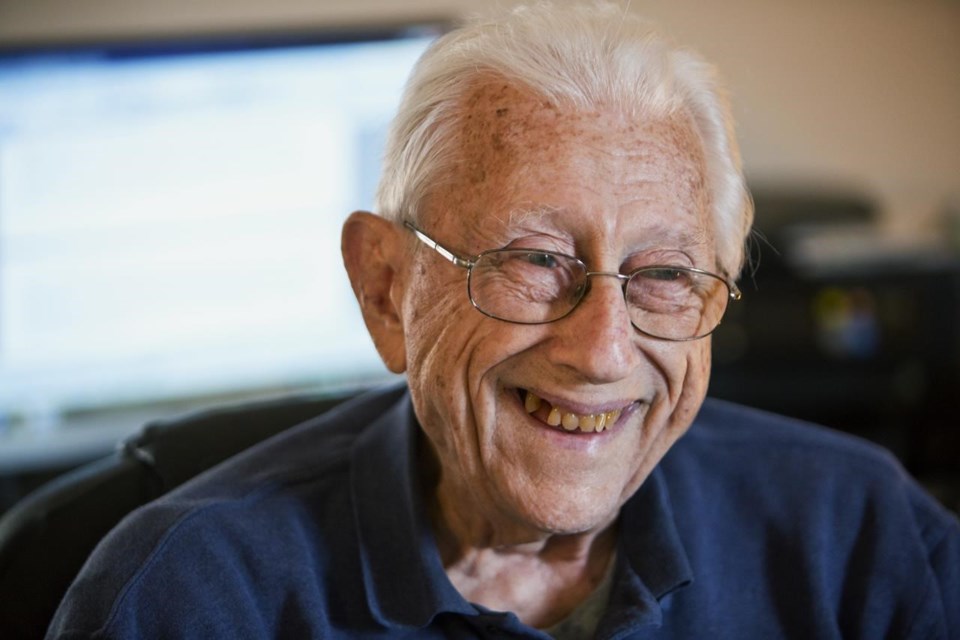RICH CREEK, Va. (AP) — Gene Herrick, a retired Associated Press photographer who covered the Korean War and is known for his iconic images of Martin Luther King Jr., Rosa Parks and the trial of the killers of Emmett Till in the early years of the Civil Rights Movement, died Friday. He was 97.
In 1956, Herrick photographed Rosa Parks being fingerprinted during the boycott that followed her refusal to move to the back of a bus in Montgomery, Alabama. That same year, Herrick captured an image of King smiling while being kissed by Coretta Scott King on the courthouse steps after being found guilty of conspiracy to boycott the city's buses.
In a 2020 interview with The Associated Press, Herrick said it was rare to get a photo of King smiling.
“I knew he was going to be let out of jail that morning,” Herrick said. “And all these people were out there on the steps waiting for him, including his wife, who reached out and gave him a big kiss.”
Herrick's longtime companion Kitty Hylton said he died at a nursing home in Rich Creek, Virginia, surrounded by people who loved him.
“He was so proud to be a journalist. That was his life,” Hylton said. “He loved The Associated Press. He loved the people of the AP. He was so grateful to have had all the adventures that he had.”
Herrick also covered the trial of two white men in the killing of the 14-year-old Till, a Black youth who was abducted, tortured and lynched in Mississippi after being accused of flirting with a white woman. The two men were found not guilty in 1955 by an all-white jury, and admitted to the murder a year later in an interview with Look Magazine.
Herrick was particularly proud of his Korean War coverage. “Good journalists want to go where the action is, wherever it is,” he said for an AP article in 2018.
In a 2015 interview for AP's corporate archives, Herrick acknowledged the danger of war photography but added, “So is civilian photography. I’ve come pretty close to getting killed many times with guns and having guns put in my chest in the riots in Clinton, Tennessee and places like that.”
He also covered sports including Major League Baseball, Elvis Presley and five U.S. presidents.
“God and the AP have given me opportunities I could never have had,” Herrick said in the 2018 AP story. “I mean, I’m the luckiest kid in the world to have done what I’ve done.”
AP Executive Editor Julie Pace said Sunday that Herrick "captured history for the AP. We, and so many people around the world, benefited from his sharp eye and the power of his visual storytelling.”
Herrick joined the AP at age 16 in Columbus, Ohio, as an office assistant. Two years later he transferred to Cleveland, where he lived with an AP photographer and often assisted him. Herrick got his big break when his roommate was unable to cover a Cleveland Indians game, and he was asked to take his place.
“They’ve got to be stupid,” Herrick said he thought at the time. “Me cover a ball game for the AP?”
Herrick was equally stunned when, not long after, he was promoted to AP photographer in Memphis. He still didn't have much experience when he volunteered for Korea in 1950, and found himself at the front lines, standing in the middle of a road, totally exposed.
“It’s a beautiful war going on. I mean, the planes are coming in, dropping napalms, and machine guns, and right there on the mountainside, and I’ve got a picture here of wounded being carried on a litter, coming up the road right at me, and, oh, I thought, man, this is great,” Herrick recalled in 2015, laughing at the memory. "I’m bam-bamming with the old four-by-five Speed Graphic, the film pack in those days. And I look around, and some GI over in a ditch says, ‘Sir?’ I said, ‘Yes?’ He said, ‘Do you see that dirt popping up there ... do you know what that is?’
And I said, ‘No. What is it?’ He said, ‘Those are bullets!' ... so I got off the road and got in the ditch with him. But I got some really nice pictures."
He formally retired from the AP in 1972, and enjoyed a second career working with the developmentally disabled in Columbus, and later in Rocky Mount, Virginia.
At age 91, Herrick was inducted into the Virginia Communications Hall of Fame at Virginia Commonwealth University – an event he considered a highlight of his life.
Herrick, who was born in Columbus and was previously married, is survived by two sons, Chris and Mark Herrick of the Indianapolis area, daughter Lola Reece of Peterstown, W. Va., five grandchildren and three great-grandchildren.
___ This version corrects the year Herrick retired and clarifies that the Parks image shows her second arrest.
The Associated Press


